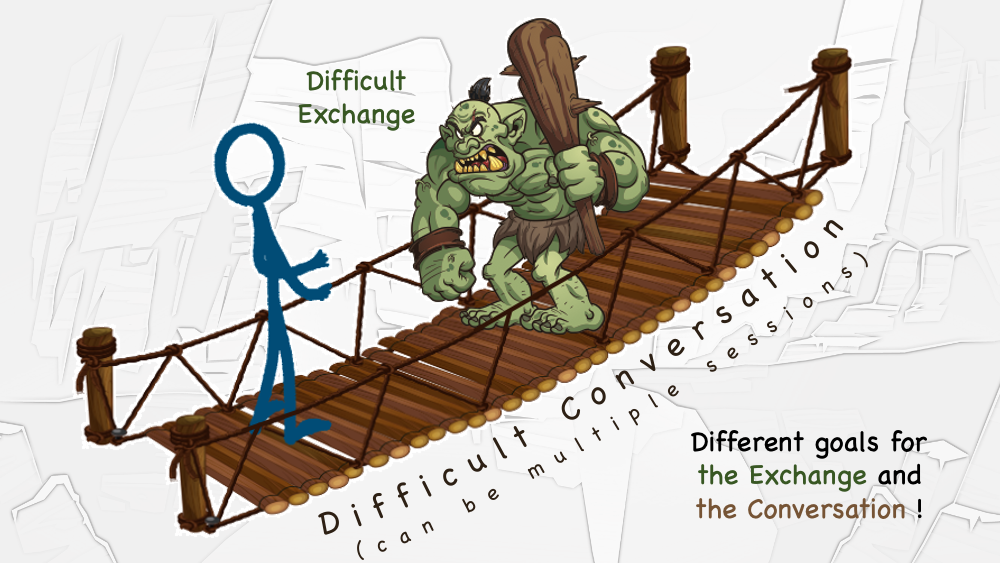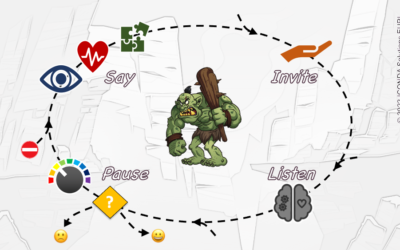Trolls are trouble when you want to cross a bridge. Especially when the bridge in question is slippery and swaying. They can takes ages to deal with and, of course, trolls present a health and safety hazard.
A Difficult Conversation is like crossing a troll bridge. The bridge itself represents the underlying, “normal” conversation [1], with one or two challenges and an objective of attaining something on the other side. The troll represents the emotion associated with a particularly difficult issue and our options are, broadly speaking, to run away (avoid the issue) or resort to force (eg. escalate the issue) or tame the troll.
Our experience is that most professionals are not well equipped to deal with trolls. When a conversation starts to become difficult, instead of taking the time to restore calm they become impatient to reach their original objective (get information, agree on something, reprimand someone, etc.), and this makes the situation worse.
Focus on the troll first
This recommendation comes from work to create a training program on Difficult Conversations for a high-tech multinational, our objectives being to help training participants:
- Tackle difficult conversations, rather than avoid them, thus reducing the accumulation of issues and the consequent deterioration of relationships across the organisation
- Tackle them with confidence and without falling into conflict
To do this, we:
- Raise awareness of ineffective behaviours
- Provide memorable models and techniques that support useful behaviours
The troll confrontation represents the Difficult Exchange
We asked ourselves not only, “what is a Difficult Conversation?”, but also, “how is a Difficult Conversation structured?”. Then, by focusing on what we call the Difficult Exchange within a Difficult Conversation, we gained clarity and reduced our subject to just the essentials. This made training both faster and more impactful [2].
In our model, the Difficult Exchange is the tough part of the conversation . It’s the confrontation with the troll. He represents the confusion of unpleasant emotions that prevent everyone from thinking straight and communicating effectively.
The rest is what you might call a “normal conversation”: a dialog resulting in a useful outcome. This dialog might take the form of a negotiation, a brainstorm, an explanation, a reprimand, an apology, an exchange of feedback or many other types of conversation that we routinely engage in. The objectives and outcomes of such conversations are varied of course: agreements, action lists, even hugs and kisses.
In contrast …
A Difficult Exchange has only one objective and two possible outcomes
My objective is to reconcile the Difficult Exchange – to return to dialog.
The possible outcomes are either that this is achieved or that we abort the conversation.
Typical actions after aborting would be to escalate an issue to higher management or to disengage from the other party, a decision that could range in severity from ceasing to communicate with someone to quitting a job, for example. These are “fight or flight” outcomes and it is obviously preferable to achieve our objective of returning to dialog (which, in this context, means a non-conflictual conversation, as already explained).
Leading Difficult Conversations
Difficult Conversations are those where feelings are running high for one or all parties. They are generally linked to situations where opinions are strongly held and where there is something important at stake. For example, a series of meetings with a collaborator to deal with a performance issue, a confrontation with an angry, confused customer, or perhaps a clash with my boss, who is unfairly refusing a salary increase. We brainstormed and came up with many examples, then received even more from trainees.
We chose the term Leading Difficult Conversations for the program because we believe that finding a way out of them requires a leadership stance. Our assumption is that a person trained to deal with Difficult Conversations will invariably find themselves in contact people who have not. We therefore aim to give them the tools, skills and confidence to resolve Difficult Conversations, whether they have a manager-leader organisational role or not and independent of their position in the hierarchy.
To bring all this together, we use a special type of role-play: film scene improvisation. We defined a handful of characters and a general scenario at the start of the training program then imagined film scenes which showed different types of Difficult Exchange. Note that we did not attempt to role play Difficult Conversations right through to the end. We focused on the Difficult Exchange part of the conversation (taming the troll), since this was where the most valuable lessons could be learnt.
The trainer took on the role of the film director and lead actor and was therefore in a position to drive the scene improvisation in a certain direction and to cut and retake wherever this would help reinforce a learning objective.
Some bridges are known for trolls, but occasionally they just jump up
In professional conversations, we often have to deal with trolls. Often, we know before we start the conversation that it is going to be difficult. Sometimes trolls jump up unexpectedly. Either way, there are techniques for dealing with them and we’ll describe a Troll-Taming Loop for reconciling a Difficult Exchange in future articles.
The associated training program is now being rolled out worldwide in the multinational where it was developed and it is also available through ICONDA Solutions in the form of a new course, Effectiveness in Difficult Professional Conversations.
Andrew Betts and colleagues
Last modified: 31 July 2022
[1] In this context, a conversation may span multiple sessions and these could use a mix of styles – face-to-face, video conferencing and email, for example. The resolution of a difficult conversation may be achieved in a few minutes or it could take hours, days or months.
[2] The audience is 1000+ professionals and to accommodate their demanding schedules the course had to teach a new process remotely in about 10 hours. We set out with the idea of using Non-Violent Communication (NVC) as a foundation. However, a basic course in NVC takes about one week and is usually done face-to-face. Furthermore, we soon realised that NVC alone didn’t cover everything we needed. It was like trying to pour 2 litres of milk into a 1 litre bottle then finding that, in fact, 3 litres would have to go in! Eventually, we found a solution by taking a huge step back … and it was then that we noticed the troll.
---
Other articles in this series
English articles : 1, 2, 3, 4, 5, 6, 7 , summary and notebook
Traductions en français : 1, 2, 3, 4, 5, 6, 7 , sommaire et cahier
Your feedback and suggestions
The Difficult Conversations eBook and articles are the result of many hours of collaborative work and they build upon a huge base of established wisdom.
I am grateful to everyone involved so far – trainees, fellow trainers and coaches, other authors … and I would also appreciate your comments and suggestions!
There is an online form or, if you prefer, an email to contact@icondasolutions.com would be fine.
As you may have noticed, ...
... the topics in this series on Difficult Conversations are organised hierarchically:
- Article 1: At the top level, a Difficult Conversation can be imagined as a bridge with a troll blocking the way, where the troll represents the Difficult Exchange which has to be sorted out before a normal conversation can resume. Our challenge is to tame the troll.
- Article 2: At the next level, we break our troll-taming method down into a four step loop: pause, say, invite and listen/decide. We go around this loop until we've Reconciled the Difficult Exchange and have returned to a normal conversation (dialog).
- Articles 3-7: Finally, each of the four steps has its own internal details and the refinement of these details takes us deeper still, as with any substantial subject.
We invite you to use the tools and models described in these articles to guide your practice and we hope that you find this hierarchical description helpful.
Comments, suggestions and enquires: contact@icondasolutions.com






